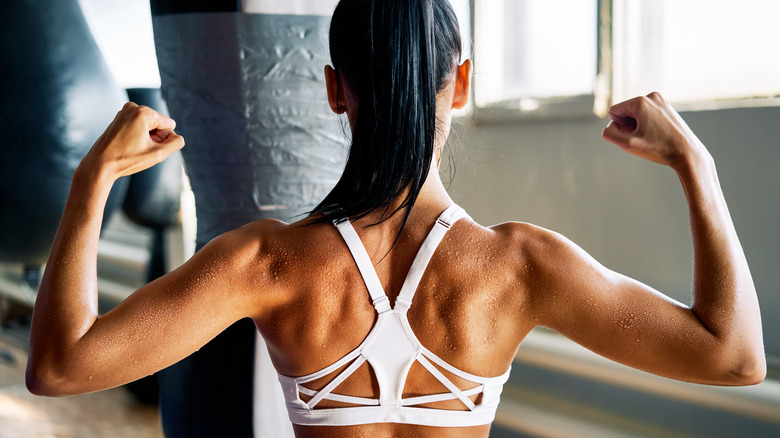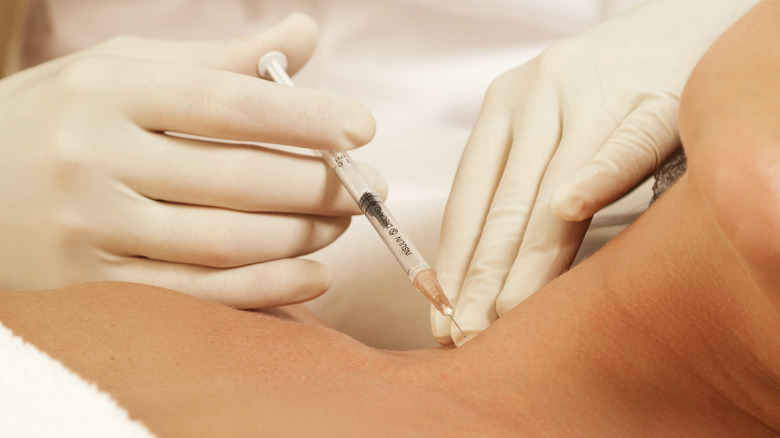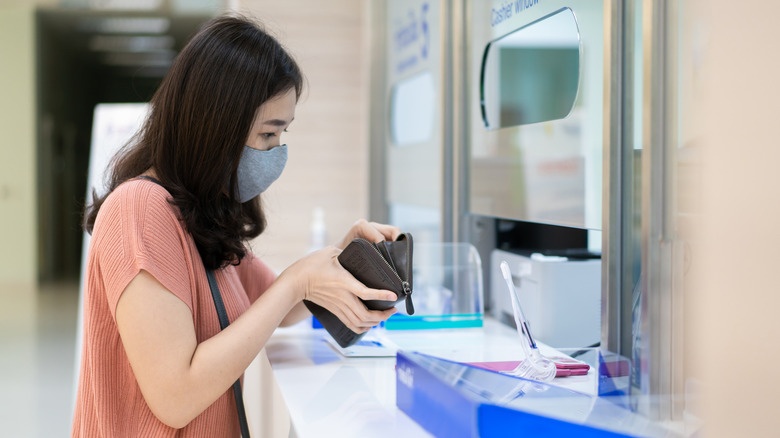'Trap Botox' Is Taking Off On Gym TikTok. What Exactly Is It?
If you know anything about cosmetic procedures, you've likely heard about Botox — a well-loved injection approved to reduce the number of fine lines and wrinkles on the face without using filler. This injection is a neurotoxin that works to essentially freeze the injected muscle and block signals that cause it to contract. On the face, this means no forehead wrinkles or smile lines from movement, but it has also found other off-label uses for treating migraines, muscle spasms, and bladder problems.
However, people are finding even more off-label uses for this injection. The trapezius, a muscle that extends from the neck to the shoulders and down to the upper back, is a major area of focus for fitness enthusiasts. Still, if you feel you've gained too much muscle during the back day or consistently find yourself with poor posture from working at home, it can result in a more bulky, rounded look than you were going for. That's where trap Botox comes in — a treatment specifically designed to target and reduce the muscle mass of this area of the body.
Cosmetic uses for trap Botox
For many women, the goal in the gym is to slim down, build strength, and increase muscle definition while still avoiding a "bulky" look. This, of course, is all a matter of personal preference — plenty of others are simply looking to gain as much muscle as possible — but for those going for the long and lean look, it's often much easier said than done. Strength training and weight lifting workouts will leave you with larger muscles in the areas you're trying to build, like the glutes and legs, but it could also leave you with gains in places you weren't necessarily looking to bulk up, like the trapezius.
If you wanted to reduce the look and size of this muscle, you could stop going to the gym entirely or exclusively focus on cardio, but that would result in an overall reduction of muscle mass, even in areas where you want to grow or maintain. As a result, many are turning to Botox injections to slim out the shoulders and neck and achieve their desired shape.
Medical uses for trap Botox
The appeal of taming an overactive trapezius isn't exclusively cosmetic. If you frequently find yourself sitting with poor posture, especially if you spend your days hunched over a phone or computer, you've likely experienced stiffness and pain in your upper back and neck. This position puts a large amount of strain on the trapezius muscle and keeps it in a state of flexion while it works to support the weight of your head. If frequently maintained, it can result in consistent discomfort and even a more rounded appearance of the shoulders, a condition sometimes colloquially referred to as text neck.
Trapezius Botox injections can help relieve some of the tension and stiffness that have developed as the result of an overactive trapezius. Of course, these shots only weaken the muscle temporarily, but they can act as a source of relief while you work on other methods to improve your posture and lessen your reliance on this muscle during your daily activities.
What to expect from this injection
The first step in getting shoulder injections should be to find a qualified doctor that offers this procedure. It's not quite as common as facial Botox, so that might take some digging. Still, it's best to find a provider with experience with trapezius Botox specifically to guarantee the best results. After scheduling a consultation and agreeing that this is the ideal procedure, you will discuss exactly what you want to accomplish from these injections. It's also likely that they'll be able to provide some before and after photos so you can better understand what the final result might look like on your body.
After this, you'll schedule your appointment and head in for your injections. This process, of course, isn't exactly pleasant, but you shouldn't feel any major pain or face any downtime after the procedure. If you're worried about soreness after injection, you can ice the area to lessen swelling and immediate discomfort once you head home.
Are there any risks?
In the grand scheme of cosmetic procedures, Botox is fairly low-risk, despite the anxiety-inducing idea of willingly injecting a neurotoxin into your muscle. The biggest issues are only really a concern if you go to a provider that isn't qualified, but as long as you ensure their practice is sterile and safe, you should be good to go. After injection, you could feel a bit sore or face some bruising at the site, but this should go away in a few days. It's also possible for Botox to spread to other areas of the body and cause impairment of function or weakness in other muscles, but this shouldn't be an issue with a qualified physician.
Of course, there's also always the risk of an allergy to Botox, though only a few cases have been reported. If you experience rashes, large amounts of swelling, hives, or trouble breathing, head to the emergency room immediately — adverse reactions might be rare. However, they should still be taken seriously to avoid any further damage.
How long do the results last?
Botox injections are metabolized at about the same rate regardless of where it's injected in the body. After your injection, Botox takes time to work. It should take about three to five days to start seeing some results, with the full look becoming clear after approximately seven to 10 days. After this, your procedure's staying power depends on your body and how quickly it breaks down the neurotoxin. For most, the muscle-freezing effects of Botox will start to fade around the three to four-month mark, but results that last only two months up to six are possible.
After this, you can either allow your muscles to return to their natural state or go back to your provider for another round of injections. How soon you schedule another visit depends on personal preference, so you can work with your doctor to create a regular appointment schedule if you want to maintain your results over time.
How much does trap Botox cost?
The cost of your full trapezius Botox session depends primarily on the pricing of your doctor, the general cost of treatments in your area, and the number of units of Botox you need to get your desired results. One unit of Botox is usually in the $10 to $15 range, and it's common to use about 50 units per side, dispersed across five different injection points to decrease the activity of an overactive trapezius. Taking both sides into account leaves you with a final cost somewhere around $1,000 to $1,500 per session, though this depends on your unique situation.
Botox treatments might be pricey, especially if you commit to a routine injection schedule after seeing your results. Still, they're one of the only methods that allow you to target muscle loss in a specific area rather than all over. Thankfully, this cost is the highest risk — if it fits your budget and you can find an experienced provider, you'll likely end up with results you'll love.






